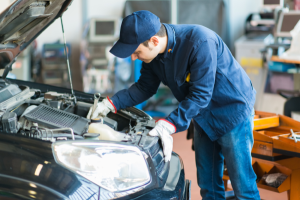ABI14110 – ABIOSH International Certificate in Automative Safety ©
 The auto industry is complicated and hazardous. There have been over 3 million injuries and 65,000 deaths in the motor vehicle industry worldwide over the last 5 years. Workers in the auto industries are potentially exposed to a variety of chemical and physical hazards. Chemical hazards may include volatile organics from paints, fillers and solvents; diisocyanates, polyisocyanates, and hexavalent chromium from spray painting operations; silica from sandblasting operations; dusts from sanding; and metal fumes from welding and cutting. Physical hazards include repetitive stress and other ergonomic injuries, noise, lifts, cutting tools, and oil and grease on walking surfaces. This course is addressed in specific standards for the general auto industry. It focuses on occupational health and safety to reduce the number of work-related injuries and improve overall work environments in the automotive industry. Successful completion of the course would enable delegates to reduce the likelihood of accidents or ill health in the workplace, it is designed to establish a vision of a safety focused culture and inspire the delegates to positively lead the culture by example and in practice.
The auto industry is complicated and hazardous. There have been over 3 million injuries and 65,000 deaths in the motor vehicle industry worldwide over the last 5 years. Workers in the auto industries are potentially exposed to a variety of chemical and physical hazards. Chemical hazards may include volatile organics from paints, fillers and solvents; diisocyanates, polyisocyanates, and hexavalent chromium from spray painting operations; silica from sandblasting operations; dusts from sanding; and metal fumes from welding and cutting. Physical hazards include repetitive stress and other ergonomic injuries, noise, lifts, cutting tools, and oil and grease on walking surfaces. This course is addressed in specific standards for the general auto industry. It focuses on occupational health and safety to reduce the number of work-related injuries and improve overall work environments in the automotive industry. Successful completion of the course would enable delegates to reduce the likelihood of accidents or ill health in the workplace, it is designed to establish a vision of a safety focused culture and inspire the delegates to positively lead the culture by example and in practice.
Introduction
Learning Outcomes
- Equip delegates with the principles of health and safety management
- To equip auto industry employees to ensure awareness of general hazards to minimize the risk of accidents and injuries at the work
- Designed to educate auto mechanics on the proper use of hand and power tools to reduce the risk of accidents and injuries
- Explains hazards of misusing hand tools, proper use of impact tools, safety with electrical power tools, and other general safe work practices
- Offers a comprehensive safety training addressing the many hazardous issues common in automotive industry ensuring workers have the appropriate knowledge to reduce accidents and injuries
- Addresses the roles and responsibilities of preventing accidents and injuries in the workplace as a result of unsafe acts of employees
- Delegates will learn hazards awareness in various weather, road and environmental conditions and what drivers must do as professionals to protect themselves and the public
Target Audience
All those involved in the auto industries including:
- Managers and Supervisors
- Engineers and Technicians
- Mechanics
- Operators
Duration: – 10 Days
Methodology
- Multimedia Power point presentation
- High-quality course video including narration, music and text
- Superior high-resolution graphics, 3D animation and illustrations
- Challenging learning activities, knowledge checks and post-tests to reinforce and evaluate employee knowledge
- Intuitive course navigation and bookmarking
Course Modules
PART 1: General Health and Safety in the Automotive IndustryFoundation in Occupational Health and Safety
- The Moral, Social and Economic Reasons for Health and Safety
- Safety culture and Training
- Leadership and Employee involvement
- Employee Safety Orientation for Automotive Personnel
- International Safety regulatory requirements
- Hand and Power Tool Safety
- Motor Fleet Maintenance Safety
- Human Behaviour / Reducing Unsafe Acts
- Hazards in the Automotive Industry 3
- Hazard Communications
- Preventing Back Injuries in auto industry
- First Aid
- Fire Extinguisher Use & Procedures
- Acid Battery and Jump-Starting
- Vehicle Inspection – Automobile and Light Trucks
- Speed Management
- Accident and Breakdown Procedures
PART 2: Safety in Motor Vehicle Repair (MVR)
- Organising health and safety in MVR
- Servicing and mechanical repair
- Bodyshops and SMART spraying
- Tyre and wheel removal, replacement and repair
- Roadside repairs and recovery
- Common issues in MVR
- Under-vehicle access
- Inspection pits
- Compressed-air equipment
- Noise and vibration
- Fire and explosion
- Flame cutting and welding
- Manual handling
- Electrical safety
- Work at height
- General working conditions
- Safety in MVR offices
PART 3: Practical Application
Inspection of an automobile factory/Shop and writing a report






